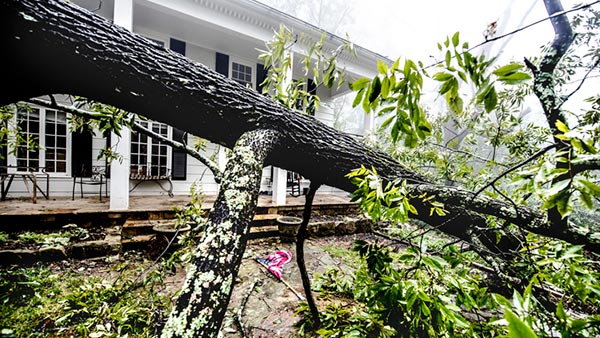
Watch for potential safety hazards after a catastrophe.
Protecting yourself and your family is your first priority in the aftermath of a catastrophic event. When your auto, home, business or personal property is damaged or destroyed by a tornado, hail, flood or other destructive event, focus on people first. Promptly treat any injuries and determine if anyone is missing. Next, remain calm and carefully survey the damage.
Be cautious during post-catastrophe activities to avoid injuries during rescue attempts and cleanup. Watch for downed power lines, gas leaks and electrical hazards that could result in fire, explosion or electrocution. Listen to local officials and emergency management personnel, who can assist you with locating emergency medical treatment, temporary accommodations, clothing, food, water and other needs.
Emergency response agencies and your insurance company will be there to assist you. Call your agent or insurance company to report your claim. Cincinnati policyholders who are unable to reach your agent to report your claim can reach us at 877-242-2544. (This number does not apply for workers’ compensation, life, annuity and disability claims.)
What you can do to streamline the claim process
- Provide your claims representative with a contact number or numbers to reach you during daytime and evening hours.
- Many areas are not accessible after a disaster due to safety concerns. If possible, let your claims representative know when the authorities allow access in order to schedule the earliest possible inspection of your property.
- Make a list of your immediate needs to share with the claims representative.
- Take photos of your damaged auto, home, business and personal property.
- Protect your auto, home, business and personal property from further damage.
- Cover openings with tarps
- Board up windows and doors
- Turn off utilities
- Drain water lines to prevent freezing
- Extract water and start the drying process
- Complete an inventory of your personal property; it’s helpful to have an inventory stored in your safe deposit box or other off-site location.
- Contact a contractor or builder to assess the building damage. If you are not familiar with the contractor or builder, request references. Some municipalities screen vendors and require registration to protect home and business owners. See our blog post about how to avoid fraud after a disaster.
- Secure a repair estimate for the damaged property, if possible.
- With extensive damage, it is helpful to have pre-loss photos, blueprints and floor plans.
DISASTER RESOURCES
These additional resources may assist you in preparing for and recovering from disaster:
- American Red Cross provides disaster relief nationally and responds to those in need globally.
- Federal Emergency Management Agency (FEMA), an independent agency of the federal government, provides preparedness and response and recovery support to the nation. The agency’s Individual Assistance page tells how to find immediate assistance.
- The National Weather Service, part of the National Oceanic & Atmospheric Administration (NOAA), a federal agency and the primary source of weather data and warnings for the United States.
This loss control information is advisory only. The author assumes no responsibility for management or control of loss control activities. Not all exposures are identified in this article. Contact your local, independent insurance agent for coverage advice and policy service.
